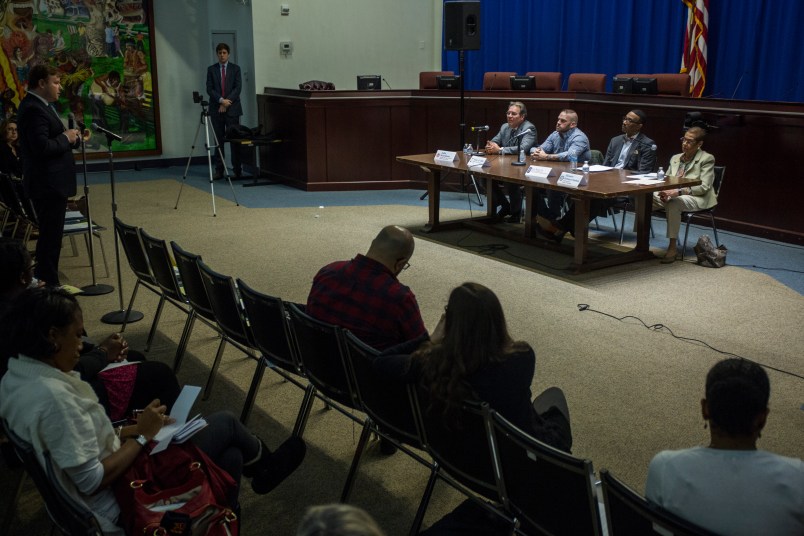As we continue reporting on the Trump administration’s closing attack against federal employees, experts and lawyers repeatedly cite an unusually old law: The Pendleton Civil Service Reform Act of 1883.
The law ended the spoils system and marked the beginning of the United States’ system of formalized, merit-based hiring for federal jobs.
And its relevance today shows just how ambitious Trump’s closing attack is: His executive order in October establishing a “Schedule F” of the civil service, as we reported last week, could strip job protections including appeal rights from thousands of federal employees engaged in the policymaking process.
Whether the administration will in fact be able to pull that off remains unclear. Politically appointed leaders around the executive branch would have to act quickly to assemble and reclassify lists of civil servants who they think ought to be easier to fire at will before Joe Biden takes office.
But even if they don’t — even if no career civil service employee is re-classified and canned before Joe Biden takes office — Trump’s executive order could serve as a legal marker for future challenges against America’s longstanding federal hiring and firing rules.
“Case by case, litigation has been chipping away at the existing understanding of the merit system and, especially, the protection of the unions,” Donald Kettl, a professor of public policy at UT Austin, told me.
The rightward shift of the federal judiciary has certainly helped this cause, Kettle said, “But, in addition, there’s a strong but not well-explored argument that the merit system, with its tenure protections, is unconstitutional.”
“These arguments have arisen from the Heritage Foundation and have support from other quarters as well,” Kettl said. “The argument builds on the president’s appointment power and holds that the Pendleton Act and related legislation since is unconstitutional because it abridges the president’s power — and that the full exercise of that power leads to Schedule F.”
The Trump administration’s designs on this front are no secret: In 2017, James Sherk, the labor policy advisor on the Domestic Policy Council, wrote a memo (published by reporters a couple years later) outlining what he called a “constitutional option” for firing federal employees.
“There are legal arguments that Article II executive power gives the president inherent authority to dismiss any federal employee,” Sherk wrote. “This implies civil service legislation and union contracts impeding that authority are unconstitutional.”
The President, he said, could therefore “issue an Executive Order outlining a streamlined new process for dismissing federal employees.”
In addition to Sherk, several Heritage Foundation alumni still serve as the point people for Schedule F: Michael Rigas, the acting director of Personnel Management (the government’s H.R. department) worked for years at the right-wing think tank. Rigas is dual-serving as deputy director for management at the Office of Management and Budget (OMB). His boss there, director Russel Vought, was formerly vice president of Heritage Action for America, the think tank’s political advocacy arm.
Whether or not Schedule F has the legal muscle that some anticipate is hardly clear. As Kenneth Warren, a political scientist at Saint Louis University, told Federal Soup early last month that “this EO means squat.”
That interview came before several executive branch leaders began working quickly to act on Trump’s order: Nearly all federal employees at OMB have been listed as Schedule F-eligible, according to multiple reports. At the Department of Energy, an internal memo from the Office of the Chief Human Capital Officer, first described by E&E News and subsequently obtained by TPM, instructs recipients to get their preliminary lists together by Dec. 11.
And even if nothing happens before Trump leaves office, Trump’s order means “there is a marker around this,” Joe Grogan, former leader of the Domestic Policy Council, told The Washington Post.
Grogan acknowledged to the Post that the executive order only came in the waning days of Trump’s first term because it had been delayed by COVID-19 — a crucial break for federal workers.
Don Moynihan, a professor of public policy at Georgetown, said his own “pet theory” was that, given the delay, the Schedule F was issued with the courts specifically in mind.
“The judicial setting is such now that this may actually have a chance of being upheld,” Moynihan said. “That is to say, there’s enough judges who have fairly strong beliefs in executive authority that they would be willing to go along with the idea that the President really has very strong powers, and that civil service legislation from Congress is largely unconstitutional because it infringes upon his executive power to manage his employees.”
“This is another example of unitary executive authority that hasn’t really been questioned in the last 140 years,” he said. “But now maybe the time is right to get it before the courts.”
It’s still unclear what the courts would make of the executive order’s assumptions about presidential power, Kettl said, but those quick to dismiss Trump’s last-minute effort are playing with fire.
“It seems doubtful that the courts would, in a stroke, wipe out 140 years of established practice,” he wrote. “But the legal case for the president’s executive order is much more subject to debate than has been apparent so far.”
“Its supporters are clearly putting down a marker for future cases — and future executive orders,” he said. “This isn’t over, by a long shot.”


 Members-Only Article
Members-Only Article
